Wed, Dec 30, 2020
AD 2020-26-12 Requires Revising The Existing Maintenance Or Inspection Program
The FAA is adopting a new airworthiness directive (AD) for certain Gulfstream Aerospace LP Model Gulfstream G280 airplanes. This AD was prompted by a determination that new or more restrictive airworthiness limitations are necessary.

This AD requires revising the existing maintenance or inspection program, as applicable, to incorporate new or more restrictive airworthiness limitations, as specified in a Civil Aviation Authority of Israel (CAAI) AD, which is incorporated by reference. The FAA is issuing this AD to address the unsafe condition on these products. This AD is effective February 1, 2021.
Supplementary Information: The CAAI, which is the aviation authority for Israel, has issued CAAI AD ISR-I-04-2020-06-02, dated June 28, 2020 (CAAI AD ISR-I-04-2020-06-02) (also referred to as the Mandatory Continuing Airworthiness Information, or the MCAI), to correct an unsafe condition for all Gulfstream Aerospace LP Model Gulfstream G280 airplanes. Airplanes with an original airworthiness certificate or original export certificate of airworthiness issued after September 15, 2019, must comply with the airworthiness limitations specified as part of the approved type design and referenced on the type certificate data sheet; this AD therefore does not include those airplanes in the applicability.

The FAA issued a notice of proposed rulemaking (NPRM) to amend 14 CFR part 39 by adding an AD that would apply to certain Gulfstream Aerospace LP Model Gulfstream G280 airplanes. The NPRM published in the Federal Register on September 16, 2020 (85 FR57799). The NPRM was prompted by a determination that new or more restrictive airworthiness limitations are necessary. The NPRM proposed to require revising the existing maintenance or inspection program, as applicable, to incorporate new or more restrictive airworthiness limitations, as specified in CAAI AD ISR-I-04-2020-06-02.
The FAA is issuing this AD to address solder cracking of the flight control electronic control units (FCECUs), which, combined with latent failure of the horizontal stabilizer trim actuator (HSTA) “no-back” mechanism, could result in uncontrolled HSTA operation. See the MCAI for additional background information.
More News
He Attempted To Restart The Engine Three Times. On The Third Restart Attempt, He Noticed That Flames Were Coming Out From The Right Wing Near The Fuel Cap Analysis: The pilot repor>[...]
Make Sure You NEVER Miss A New Story From Aero-News Network Do you ever feel like you never see posts from a certain person or page on Facebook or Instagram? Here’s how you c>[...]
From 2009 (YouTube Edition): Leading Air Show Performers Give Their Best Advice for Newcomers On December 6th through December 9th, the Paris Las Vegas Hotel hosted over 1,500 air >[...]
Aero Linx: NASA ASRS ASRS captures confidential reports, analyzes the resulting aviation safety data, and disseminates vital information to the aviation community. The ASRS is an i>[...]
“For our inaugural Pylon Racing Seminar in Roswell, we were thrilled to certify 60 pilots across our six closed-course pylon race classes. Not only did this year’s PRS >[...]
 NTSB Final Report: Rutan Long-EZ
NTSB Final Report: Rutan Long-EZ ANN FAQ: Turn On Post Notifications
ANN FAQ: Turn On Post Notifications Classic Aero-TV: ICAS Perspectives - Advice for New Air Show Performers
Classic Aero-TV: ICAS Perspectives - Advice for New Air Show Performers ANN's Daily Aero-Linx (06.28.25)
ANN's Daily Aero-Linx (06.28.25) Aero-News: Quote of the Day (06.28.25)
Aero-News: Quote of the Day (06.28.25)




